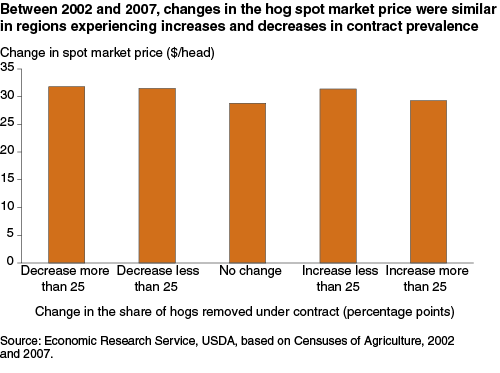Hog Spot Market Prices Not Strongly Associated With Production Contracts
- by Nigel Key
- 3/1/2012
ERS researchers used farm-level data from the 2002 and 2007 Censuses of Agriculture to examine the effect of increasing use of hog production contracts on market prices, often referred to as 'spot market' prices. Comparing the prices received by independent producers in regions of growing contract production with the prices in regions of shrinking contract production, researchers found no strong relationship between contract prevalence and spot market prices.
In recent decades, the share of hogs raised under production contracts has increased from 5 percent in 1992 to 67 percent in 2004. Under a production contract, contractors (meatpackers or integrators--companies that contract with many growers and collect the hogs for processing or marketing) typically provide feeder pigs, feed, and other inputs to farm operators who raise the animals to market weight. Contractors own the hogs and compensate farmers using a formula that often includes incentives for high feed efficiency and low death loss.
The benefits of production contracts may help explain their growing prevalence. Contracts offer lower income risk for farmers and enhanced control over product quality and flow for meatpackers. The transition to production contracts, however, has raised concerns about how spot market prices are determined for independent hog farmers--those not under contract.
Because contract producers do not sell the hogs they raise, the shift to contracting has meant a pronounced decline in the number of spot market hog sales. In theory, meatpacking firms could use long-term production contracts to 'tie up' local production, thereby discouraging the entry of competitors in local markets. Without competition, meatpackers might then be able to suppress spot market prices.
Between 2002 and 2007, the average price received by all independent producers who specialized in growing hogs to market weight increased by $31.19 per head. In counties where the share of production under contract decreased or increased by a small amount (fewer than 25 percentage points), the average price increased by about $31.50 per head. Price increases were lower in counties where contracting prevalence either did not change or increased by more than 25 percentage points. However, the average-price differences between all the groups were relatively small. A more rigorous ERS analysis that controlled for farm and regional characteristics did not find an economically significant association between contract prevalence and spot market prices.
This article is drawn from:
- 'Does the Prevalence of Contract Hog Production Influence the Price Received by Independent Hog Producers?'. (2011). Journal of Agricultural and Food Industrial Organization. Vol. 9, Issue 1, Article 2, p. 26 .
You may also like:
- Key, N. & McBride, W.D. (2007). The Changing Economics of U.S. Hog Production. U.S. Department of Agriculture, Economic Research Service. ERR-52.


